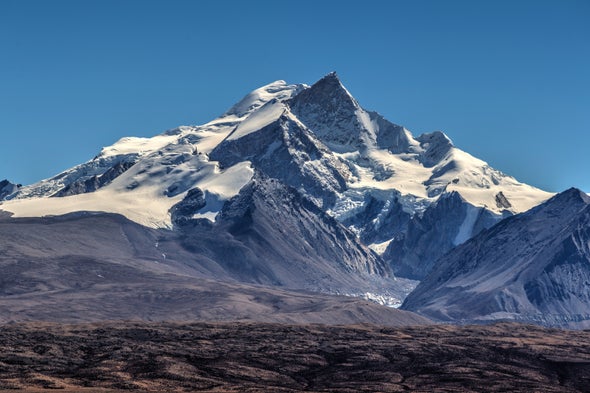(单词翻译:单击)
听力文本
This is Scientific American's 60-second Science, I'm Susanne Bard.
Near the end of the 18th century, the industrial revolution began to transform Great Britain. Machines replaced hand tools, factories sprouted up in cities and towns, and a sharp uptick in coal combustion polluted the skies. The industrial revolution, and the pollution that followed in its wake, soon spread to the rest of Europe. But some of the smoke and ash didn't stay there. It also drifted into the upper atmosphere and was blown by winter winds all the way to the frigid Himalayas.
"This ash was transported for thousands of kilometers. And eventually, it was deposited with the snowflakes."
Environmental scientist Paolo Gabrielli of the Ohio State University. His team found signatures of airborne pollution from the beginning of the industrial revolution in Tibet—specifically, in ice cores taken from a glacier nearly 24,000 feet above sea level on Mount Shisha Pangma. Such ice cores are like time capsules that contain a record of the contaminants that were mixed in with each year's snowfall.
"And we are able to count annual layers from the surface down to a depth, in this case, of even more than 500 years, covering a time period between the year 1500 A.D. to 1992. At the beginning of our record, we didn't observe any kind of anthropogenic contribution in our ice. And this lasted until about the year 1780. At that time, we start to observe an enrichment of some trace metals."

These metals included zinc, chromium, nickel and cadmium.
The industrial revolution also coincided with a rapidly growing global population. The increased demand for food led to the expansion of croplands. Gabrielli thinks that the practice of burning forests to clear land for agriculture may have also contributed to the trace metals found in the ice cores.
The study is in the Proceedings of the National Academy of Sciences.
This finding is not the first time ice cores have revealed signs of human pollution from the past. A previous study showed that a glacier in the Andes Mountains of South America bore traces of toxic elements like lead and arsenic, deposited during colonial silver mining operations in the 16th century, more than 200 years before the industrial revolution.
"We have contaminated even the most remote areas of the world. And so, at this time, there is most likely no glacier on earth that does not show a trace of our presence."
Thanks for listening for Scientific American's 60-second Science. I'm Susanne Bard.
参考译文
这里是科学美国人——60秒科学系列,我是苏珊娜·巴德。
18世纪末,工业革命开始改变英国。机器取代了手工工具,工厂在城镇里涌现,煤炭燃烧量急剧增加导致了空气污染。工业革命和随之而来的污染很快蔓延到欧洲其他地区。但有些烟雾和灰尘并没有停留在欧洲。它们还飘到了上层大气,之后被冬季的风一路吹到寒冷的喜马拉雅山。
“这些灰尘被运送了数千公里。最后和雪花一起沉积。”
俄亥俄州立大学的环境科学家保罗·加布里埃尔说到。他的团队在西藏发现了工业革命初期的空气污染特征,具体来说,他们在希夏邦马峰上一个海拔近2.4万英尺冰川采集的冰芯中发现了污染。这种冰芯就像时间胶囊,里面记录着每年降雪时混入的污染物。
“我们能够计算从地表到深处的年层数,在这种情况下,年层可能超过500年,在公元1500年到1992年之间。在记录初期,我们并未在冰层中观察到任何人类活动的影响。这种情况一直持续到1780年。那时,我们开始观察到一些微量金属的富集。”
这些金属包括锌、铬、镍和镉。
工业革命期间,全球人口也在迅速增长。对粮食需求的增加导致了农田的扩张。加布里埃尔认为,燃烧森林以开垦农田的做法也可能是冰芯中发现微量金属的原因之一。
这项研究发表在《美国国家科学院院刊》上。
这一发现并不是冰芯第一次揭示出过去人类污染的迹象。此前的一项研究表明,南美洲安第斯山脉的一座冰川中有铅和砷等有毒元素的痕迹,这些元素在16世纪殖民地银矿开采作业期间沉积,比工业革命早了200多年。
“我们甚至污染了世界上最偏远的地区。因此,现在,地球上很可能所有冰川都有我们存在的痕迹。”
谢谢大家收听科学美国人——60秒科学。我是苏珊娜·巴德。
译文为可可英语翻译,未经授权请勿转载!
重点讲解
重点讲解:
1. all the way (强调距离)一路;
He had to walk all the way home.
他不得不一路步行回家。
2. coincide with 巧合;同时发生;
Publication of his biography was timed to coincide with his 70th birthday celebrations.
他的传记特别安排在他的70寿诞庆典时出版。
3. lead to 招致;致使;导致;
Many factors can lead to growth retardation in unborn babies.
许多因素可以导致胎儿发育迟缓。
4. contribute to 促成;促使;是导致…的原因之一;
Medical negligence was said to have contributed to her death.
据说医务人员的玩忽职守是她死亡的原因之一。


